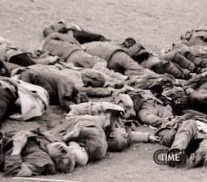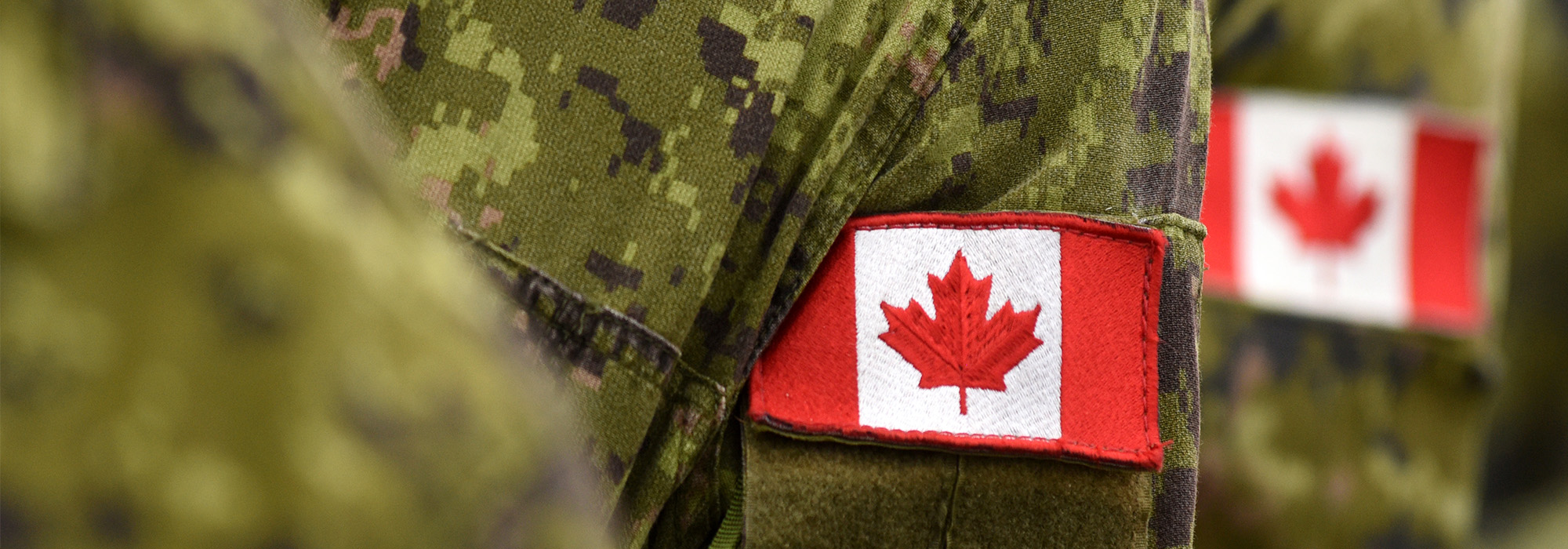
The prevailing view outside the Canadian national security policy subculture is that Canada is some sort of meek neutralist entity, an ”unmilitary” people, that only deploys force when pushed into it by other countries. What are the origins of this perception? One could point to the declarations of the academic and media punditocracy of the 1960s that Canada was a so-called ”middle power,” not only because of its size but also because its geography put it literally in the middle, between the superpowers. The evolution of such thinking in the 1970s built on this idea. During the Trudeau era, it was fashionable to present Canada to the world as an honest broker or linchpin between the West and the Third World. In fact, in 1977 the Trudeau government even explored declaring Canada a Third World country. Canada was not the nasty United States and, in keeping with the doctrine that Canadians define themselves as ”not American,” anything that was aggressive was deemed American and thus not Canadian.
Unfortunately, Canada’s previous use of military force was not consistent with this new image and, coupled with the Sixties’ generation’s ideology cum popular cultural product that in the future you could avoid war by not talking, thinking or planning for it, the history of and motivation for Canada’s overseas interventions were suppressed at virtually all levels, from the public education system to National Defence Headquarters’ operations planning section. The eminent propagandist Gwynn Dyer went so far as to muse on several occasions that it was inconceivable to him that the security of Canada could rest on the Rhine or the Inner German Border.
Canada has projected power overseas for a wide variety of reasons. Many were in fact related to national self interest; and they were not always the result of manipulations by perfidious, imperial Brits or arrogant, messianic Yanks. In essence, Canada has generally deployed its forces overseas for reasons of ”forward security,” a Canadian strategic tradition dating back to the 1800s. ”Forward security” is an ex post facto label placed on a series of actions which appear to fit into a similar category. It is not a policy, nor is it a strategy per se. Strategies and policies receive far more articulation but are difficult to transmit through successive generations of foreign policy and military people, let alone changes in government. There is, however, a definite trajectory in Canadian national security policy and forward security is clearly part of it.
Canada’s longest-lasting overseas deployments occurred during the Cold War. Practically every instance of deployment related to the larger trajectory of this restrained but vital struggle. Unlike the other wars in the 1900s, the Cold War was a ”war without battles,” fought, not in the field, but in the hearts, minds and psyches of the antagonists—except, of course, in the Third World, which was visited with impressive amounts of devastation in the proxy fighting that flowed around the nuclear-armed stalemate in Europe.
Canada’s first overseas commitments were directly related to her position as a leader of the North Atlantic Treaty Organization. Before 1951, the prevailing view of the Canadian government, first under Mackenzie King and then Louis St. Laurent, had been that the United Nations had failed as a collective security mechanism and that only a new but smaller organization, NATO, could guarantee the security of Canadian interests in the face of a new totalitarian threat, one which eventually would acquire the means to use atomic and thermonuclear weapons. Canada participated in the formulation of the North Atlantic Treaty and was in full accord with its famous Article Five, which held that aggression against one member of NATO was aggression against all. Secretary of State for External Affairs Lester B. ”Mike” Pearson and many of his advisors, however, were of the mind that Article Two, which emphasized non-military cooperation in NATO, could become a viable means to secure western countries against Communism through economic cooperation and development. In their view, military considerations took a back seat.
In the event, war did not come to Europe. Communist forces instead attacked South Korea, sparking a conflict that was seen within NATO circles as a feint to draw western strength away from Europe. In Canada, there was some debate about Korea. The motives for Canadian involvement initially were related to propping up the United Nations as an effective Cold War tool: The UN Secretary General, Trygve Lie, asked UN members for troops to fight in Korea, and the Americans were pressuring their allies to provide reinforcements while they held the line with the South Koreans. The decrepit state of Canadian military forces meant that only three destroyers could be sent immediately, while the possibility of a ground commitment would have to be explored. Canada was attacked in the world press for sending only a token, limited liability force and for not living up to its rhetoric in UN and NATO forums.
In view of this criticism, we must consider the possibility that national pride was a factor—in addition to the desire to contain Communist aggression and prop up western Europe—when the St. Laurent government made the decision to dispatch 25 Canadian Infantry Brigade Group to Korea. At the same, time the government was determined that Korea would not be another Hong Kong: Back-door cajoling was not taken into consideration as it had been in the Hong Kong disaster, and strict measures were taken to ensure that Canadian forces would not be misused. Otherwise the already established strategic tradition of Canada fighting overseas to keep aggression away from North America and protect her markets was in play.
By contrast, the decision to deploy Canadian land forces to western Europe as part of NATO’s Integrated Force, was made almost by accident. The perception that the Canadian government was reluctant to become engaged overseas is erroneous. After Korea, it was more a case of careful and slow analysis before deciding on the nature of the contribution. This was related to several factors, among them fear of political repercussions in Quebec if Canada tried to maintain a fully mobilized military force on a Second World War scale, a possibility Mackenzie King had in any case obviated by cutting the military to the bone precisely to avoid such an eventuality.
A pre-Korea planning exercise in which Canadian representatives participated had produced an unapproved hypothetical NATO force structure. Under the pressure of events in Korea, this structure was implemented and Canada was asked to contribute a division. The Canadian government chose instead to commit one brigade group and raise two more but keep them based in Canada. Canada’s credibility in the alliance was at stake both because of her initial minimalist contribution to Korea and because of the lack of a sufficient land force contribution to deter the Soviets after the Berlin Crisis. The government concluded that the threat to Europe was a real one and decided to commit 27 Canadian Infantry Brigade Group to NATO forces deterring Soviet moves in Europe. Canada could not stand idly by and throw away the benefits of the all too recent sacrifice made by her soldiers, sailors, and airmen securing the freedom of western Europe against the Nazi threat.
At the same time, a NATO air force planning exercise almost resulted in a similar commitment until the Minister of Defence intervened and stopped it. After careful consideration, however, Canada eventually committed an air division of 12 fighter squadrons to NATO. This was done for the same reasons as the decision to commit 27 Brigade, though there were also ancillary industrial benefits since the F-86 fighter used by the force was built in Canada and then exported in quantity to almost every NATO country.
And what of that vaunted, supposedly Canadian invention, UN peacekeeping? Every one of the UN peacekeeping and peace observation operations which Canada participated in from 1948 to 1968 was directly related to the Cold War game of ”position.” Canadian analysis of NATO strategy (which, incidentally, Canada influenced in its formulation) suggested that a nuclear stalemate would grow deeper and deeper in Europe, which would force the Soviets to accomplish their aims in other ways and areas, particularly areas peripheral to the NATO area. One means by which such moves could be countered by the West was to ensure that the power vacuum generated by decolonization was replaced with entities friendly to the West, or to generate stability in those areas using UN forces as the mechanism.
When we look at the pattern of Canadian UN deployments during the first 20 years of the Cold War, a definite pattern emerges. Canada deployed forces overseas for; nuclear crisis stabilization in the 1956 Suez operation; to prop up a UN effort to prevent Soviet intervention in the Third World (in the Congo in 1960); or to prevent a crisis over Cyprus involving NATO allies from escalating to the point where it could be used by the Soviets to gain advantage against NATO. Just as the Americans used the CIA to wage a twilight war against Communist expansion in the Third World, Canada used UN peacekeeping deployments as surrogates to achieve Canadian aims in that fight.
There is, of course, the anomaly of Canadian involvement in Indochina during this period. The International Commission for Supervision and Control (ICSC), a non-UN peace observation force established in 1954 that included several hundred Canadians, was also used by Canada and the West in an effort to contain Communism in Asia. After Korea and particularly after Dien Bien Phu, Western powers were less and less willing to commit forces to fight in Asia. The ICSC served as a minimal-cost means of staving off Communist interference for the time being, although, as we now know, it ultimately failed.
Canadian peacekeeping deployments in the 1970s and 1980s were essentially extensions of those established in the 1950s and 1960s, although they were more advanced versions set in a more complex geo-strategic space. We should view Canadian contributions to these missions as expressions of forward security, while keeping in mind that they were also used to stabilize the Middle East after the nearly-nuclear Yom Kippur War of 1973. Again, Canadian aims were related to the protection of Western interests both from a security and an economic standpoint within the umbrella of the Cold War.
It was also during the Trudeau era that Canada revived its tradition of gunboat diplomacy, particularly in the Caribbean. Canadian naval forces were employed on several occasions in the region to exert a Canadian presence or to evacuate Canadian citizens. In other cases, particularly in Haiti in 1974, Canadian naval vessels carried out humanitarian aid operations to generate goodwill with the Haitian government so that Haiti would support Canadian initiatives in la francophonie designed to limit French interference in Canadian affairs. Canadian naval and land forces also conducted exercises regularly in Jamaica to exert a stabilizing presence in that country, a goal that was in part related to Canadian regional commercial interests and economic competition with the United States. Many of these small-scale uses of our military forces occurred within the umbrella of the Trudeau Government’s ”Third Option” policy, that is, catering to the Third World to develop markets which the United States and Europe had difficulty accessing because of Cold War bipolarity.
The historical record is still under construction for the variety of Canadian deployments which occurred during the 1990s. Analysis of exactly why Canada participated in certain deployments therefore remains tentative. The popular notion that the end of the Cold War unleashed a world-wide orgy of anarchy is somewhat overblown. The world had also witnessed what we would now call ”ethnic cleansing” in the late 1940s and throughout the Cold War period, though much of it was hidden away behind the Iron Curtain. Anarchy and racial violence were ongoing staples on the African continent long before 1990: the Congo, Rhodesia, South Africa, and Mozambique are but a few examples. We might even consider the Iraq-Kuwait conflict as an extension of existing tensions in that region. The re-emergence of instability in the Balkans, however, could reasonably be considered a direct result of the end of the Cold War.
Why did the end of the Cold War make a difference? There was a belief that the collapse of the US-Soviet bi-polar world system would free up the United Nations so that it could perform the functions that policymakers believed it had been constructed for in 1945. Russia’s preoccupation with its domestic situation would perhaps contribute to more effective UN security oversight. There was also a greater willingness amongst some Western powers to back off and let the UN get involved. The Canadian peacekeeping myth now swung into high gear and the real reasons for Canadian involvement with UN peacekeeping, that is, power projection on behalf of NATO interests, were forgotten—or at least deeply suppressed—in the halls of the Pearson Building. There was now a significantly greater willingness to automatically accede to UN requests for Canadian involvement: Isn’t that what Canada just did? We’ve always done it, haven’t we? After all, we invented peacekeeping, didn’t we?
The seeds were sown in 1989 with the various peace observation deployments to Central America. The events of 1990, however, soon overshadowed them, as the West developed means to respond both to Iraqi aggression against Kuwait and to the ensuing regional instability, which affected world-wide economic stability. The response of the Canadian policymaking community was somewhat convoluted. An escalating series of military options was generated and presented to the Mulroney government, which was in fact divided on the issue and received conflicting policy advice. One school of thought held that the dispatch of Canadian forces would damage Canada’s (mythical) image as a neutralist UN peacekeeper. It was ultimately successful in preventing full and effective participation in the ground and air campaigns against Iraq. As a result, Canadian prestige was damaged—a policy-making failure that affected future Canadian deployments.
It is becoming clearer, for example, that the myriad Canadian deployments to the Balkans were in part intended to repair the damage done both by the minimalist Canadian participation in the Gulf and by the decision taken by senior bureaucrats in National Defence HQ to withdraw stationed Canadian forces from NATO in Europe, which had hurt Canadian relations within NATO circles. The two events combined had sent a message, perhaps inadvertently, that Canada was on the verge of isolationism on a par with that implemented by the Mackenzie King government in the 1930s.
The first Canadian operation in the Balkans saw 15 Canadian officers serve with the OSCE-mandated European Community Monitor Mission starting in 1991. This deployment was eventually followed by a mechanized infantry battalion, a battle group based on an armoured regiment and a logistics battalion and a reduced brigade group to support it all. In time, Canada also contributed a C-130 aircraft to the Sarajevo humanitarian airlift and then a destroyer or frigate (depending on the rotation) and two Aurora maritime patrol aircraft to the NATO-led but UN-mandated maritime interception operation in the Adriatic.
This significant Canadian involvement in the Balkans was not motivated by UN-style altruism. It was only after proposals for a European force had been explored and rejected that the concept of a UN force was activated. The UN was the last resort, not the first, and Canadian participation should be seen as a continuation of the realist tradition of forward security. In terms of both scale and length of commitment, Canadian operations in the former Yugoslavia overshadowed any other Canadian overseas operation since the dispatch of forces to Korea or to forward positions in NATO. What was it about this conflict that justified such a large Canadian commitment? Despite our ill-conceived, hasty and wrongheaded withdrawal from NATO in Europe, the realities of European stability and the close relationship between the two continents dictated that Canada remain involved. The strategic tradition of forward operations to prevent overseas crises from affecting Canadian interests overrode the isolationist elements that run deep within the bureaucracy. There was serious concern that the rest of newly-freed Eastern Europe might follow Yugoslavia into the abyss and affect other NATO members, which in turn would involve Canada under Article Five, not to mention the negative impact it could have on trade and other relationships.
The principle of forward operations does not explain Canadian participation elsewhere in the early to mid-1990s, however. If we examine the various UN-mandated operations in and around Haiti for almost three years, Canada deployed a destroyer to conduct maritime interception and an air-mobile light infantry battalion. We also deployed a logistics unit to Cambodia, again under UN auspices. In Africa, Canadian troops and observers were deployed to Namibia and Angola and there was a plan to insert the Canadian Airborne Regiment into West Sahara for UN duty in 1992, though it was not executed. A polyglot of Canadian support units were deployed to place a band-aid over the gaping machete wound of the blood-drenched jungles of Rwanda in 1994-95. Canadian observers were sent to Mozambique in 1993-94, and to Central America on a number of occasions from 1992 to 1997.
None of these operations had any direct bearing on traditional Canadian national security interests, though the Haiti operations were related to domestic political concerns. The refugee flow from Haiti to American-controlled areas posed significant domestic and international political problems for the United States and our assistance was requested. However, Ottawa was not merely operating in ”helpful fixer” mode: At least 60,000 votes from the Haitian émigré community in Montreal were at stake, and the fact that an election was in the offing played a strong role in the decision to have Canada deploy significant military forces to Haiti. Indeed, one naval analysis of the Haiti maritime interception force, to which Canada contributed a destroyer, noted that aspects of the operation mandated by DFAIT were being done for the sake of ”optics,” an informal DND codeword for the use of military forces for political showmanship.
By contrast, it is extremely difficult to explain what national interest the Canadian government had in deploying troops to West Sahara, Cambodia, or Rwanda. Perhaps the historical record has yet to reveal hidden reasons: That certainly has been true for earlier Canadian peacekeeping operations. Eventually it may become clear there was more to these missions than just a desire to respond to UN New York’s continual requests for Canadian participation.
It is even more difficult to make the case for the deployment of significant Canadian forces to Somalia in 1993-94, forces which included the Canadian Airborne Regiment, helicopter support, and an operational support vessel. It is increasingly evident that the so-called ”CNN factor” played a major role in motivating American involvement and this could account for Canadian involvement, too.
One study suggests that the Americans asked Canada to participate in order to broaden international support for American intervention. The study is unable to uncover, despite the small mountains of documentation released for the Somalia Inquiry, why exactly the Canadian government was motivated to agree. Was there some hidden geo-strategic agenda in play relating to the Arabian Gulf or the Middle East? Was Canada helping the Americans out of a jam? Was it a matter of pervasive amounts of manipulated images on the television influencing policymakers concerned about domestic political agendas?
We must never discount the possible role of ego, hubris, and vanity as factors contributing to the decision to deploy Canadian forces overseas. The highly embarrassing Zaire expedition in 1996, called ”the bungle in the jungle” by Canadian military personnel, demonstrated to the world that Canada was incapable of mounting and then leading a major international peacekeeping or humanitarian intervention operation.

The Canadian Airborne Regiment marches its colours the day before being disbanded (March 1995). CP Picture Archive: Tom Hanson
One journalist argues that the motives for Canadian involvement in the Zaire operation flow from attempts by the Chrétien government to secure a Nobel Peace Prize for foreign affairs minister Lloyd Axworthy and/or Raymond Chrétien and thus knight either of them as Mike Pearson’s moral and spiritual successor, perhaps to validate both the concept and main proponent of ”soft power,” or for domestic political consumption. He may well be correct.
« Soft power » itself may play a role in influencing some Canadian overseas deployments. Elevated to the status of a foreign policy by the bureaucracy and the Canadian punditocracy, but not explicitly explained in any public policy document, ”soft power” revolves around the beliefs that: the utility of military force has declined since the end of the Cold War; non-governmental organizations are in the vanguard of international diplomacy; and security should be focused on global human security not state power.
During the Cold War, Canada deployed military forces overseas within a defined strategic concept to deter communist aggression and stabilize parts of the world to prevent Canada from becoming a radioactive charcoal briquette a mari usque ad mare. By comparison, what was ”soft power” supposed to achieve for Canada? Stabilize the world for globalized capitalism? Function as a newer version of Trudeau’s Third Option so that Canadian business could penetrate the Third World? Make the world a better place? Demonstrate something—though what exactly?—to our larger allies and trading partners? To ourselves?
”Soft power” has been used to justify a wide variety of Canadian overseas activities. One entity which morphed out of the ”soft power” engine was the creation by National Defence (at the urging of DFAIT) of the Disaster Assistance Response Team (DART) in 1996. DART started off as a purely domestic rapid response assistance relief force consisting of 180 secondarily-tasked existing personnel from medical, signals, and engineering units.
In time, DART or elements of it, would be deployed to Zaire (1996), Honduras (1998), and Turkey (1999). The Honduras and Turkey operations were responses to non-man made disasters and could be classed alongside the multitude of humanitarian operations conducted by Canadian forces since the 1960s. However, those operations usually consisted of transport aircraft that would deliver supplies and depart. DART stayed on the ground: Its mission was ”to deploy and conduct humanitarian relief operations with the minimum viable operational capability in order to achieve the greatest possible impact.” In other words, DART involved a limited capability for a limited time in disaster zones which were massive. It is not difficult to view DART as an ”optics” device within the context of greater global military participation in international humanitarian relief efforts. In fact, a number of large NGOs resent the DART’s presence because it competes within the finite space of international press coverage which they use to acquire funds and self-perpetuate themselves.

Kosovo, May 1999. CP Picture Archive (AP/ CNN/Time-Warner: Ilir Loshi)
Unfortunately for the proponents of ”soft power” it became evident by 1999 that Slobodan Milosevic and Saddam Hussein and the rest of the violent world did not want to play by their rules. The continual vilification by the media and the international community of any and all ethnic Serbs in the Balkans in the early 1990s served to tilt the balance of impartiality over time. Atrocities conducted by the Croatians and non-Serbian Bosnians were wished away and overshadowed by bigger, more public ones which resembled the Holocaust: Srebrinica is an example. The Serbians did not help their case by using disproportionately violent methods to maintain control over Kosovo and they were unable to match the sophisticated Kosovar propaganda and information warfare effort. This in turn prompted Western governments already stung by the ”CNN effect” over Bosnia, Somalia, and Rwanda to react with vigorous and overwhelming military force to expunge those ghosts—while at the same time the same people who criticized Western inaction in Africa criticized NATO for acting over Kosovo!
Canada’s contradictory positions within the UN, NATO and in the Balkans could only be reconciled by actively participating in the attempts to stabilize the situation with a non-UN but ECMM-like force (the Kosovo Verification Mission), with the provision of a CF-18 squadron in the ground strike role and eventually with a Coyote reconnaissance squadron, a helicopter squadron, and a mechanized infantry battle group. Traditional impartial peacekeeping had failed on a grand scale and now a less impartial peacemaking mission was the only solution to containing Serbian aggression, bolstering the Canadian position in NATO and Europe, and maintaining Canadian foreign policy continuity. Our operations in the Balkans seemed to demonstrate that Canada did not, in fact, deploy its forces overseas for reasons related to ”soft power.” In fact, it deployed them to maintain stability in Europe for traditional reasons of forward security.
Just as it began to appear as though Canada was getting back to its roots, in 1999 the winds shifted yet again. Canada embarked on a mission that even within the ”soft power” construct made little strategic sense. Except for devotees of Noam Chomsky, most Canadians would not have known that Indonesia had been conducting rather brutal operations against the East Timor resistance since the 1970s. In time, a UNmandated but non-UN commanded international peace operation (INTERFET) was mounted. The Canadian government announced that 600 troops would be sent to East Timor as part of INTERFET. As DND planners scrambled to figure out how they could chop an existing unit to meet the government’s out-of-a-hat number, Foreign Minister Axworthy told the public that the operation was designed as a demonstration in human security. He did not indicate that any other Canadian interests were in play, though some day the historical record might reveal why Canadian forces were siphoned off from other vital missions or badly needed rest rotation and placed at risk on a small island in the Pacific.
Following Kosovo, there were whispers in the halls in Ottawa that the Foreign Affairs Minister and others were concerned that too many Canadian ”peacekeepers” (i.e., soldiers on peacekeeping duty) were wearing green helmets instead of blue ones. In fact, more Canadian personnel were engaged in NATO operations in and around the Balkans than in UN operations elsewhere. This was considered a problem amongst those who believed that the New World Disorder should be policed by the UN and not NATO. Within months, Canadian soldiers were deployed in limited numbers to UN operations in Sierra Leone, the Congo, and Ethiopia/Eritrea. As with Somalia, Zaire, West Sahara, Mozambique, Namibia and Rwanda, there has been no adequate public justification for these deployments. What exactly is the strategic rationale for them? Perhaps there is one—or several—but if so they are for the time being a secret buried deep in the Pearson Building, safely away from the Canadian people.
It is evident that there is a longstanding Canadian strategic tradition of ”forward security,” a tradition that started in the 1880s and remains in effect today. One difference between now and the past, however, is that in the past Canadian policymakers eventually figured out that Canada had to have significant and capable forces to back up that policy if Canada were to achieve her national objectives, namely economic prosperity and security for all Canadians. For the first two decades of the Cold War, Canada maintained such a capability. Unfortunately, a myth based on a Nobel Peace Prize took hold. This myth maintained that UN peacekeeping was the central pillar of Canadian national security policy and should be the repository of the bulk of the resources dedicated to it. In reality that pillar was actually NATO and other collective defence measures. Canada’s strategic tradition, which has served her well for over one hundred years, was subsequently lost in the fuzziness of the Canadian response to the New World Disorder, which was hopelessly optimistic in making the United Nations its central pillar. If we do not come to understand this, we are doomed to repeat missions like Somalia, or the Zairian ”bungle in the jungle” on one hand, or Hong Kong and Dieppe on another.
Photo: Shutterstock






